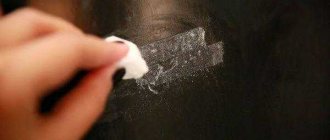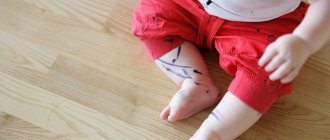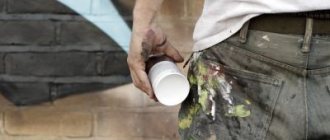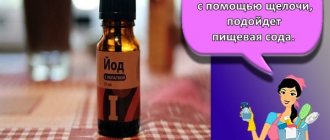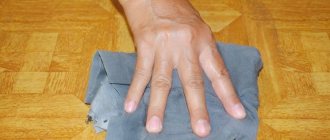After treating wounds with a medical solution, yellow marks remain on the skin, hands and nails, which disappear within a few days. But if you need to get rid of a stain as soon as possible, it is important to know how to wash off iodine. In this case, the question may concern not only cleansing the skin, but also clothing, furniture and other surfaces. You can get rid of traces of the solution yourself at home, using available means and available methods.
Iodine is an antiseptic drug used to treat wounds. The yellow pigment washes off on its own within a few days, but available products will help speed up the process.
The article contains useful tips and the most effective ways to clean various surfaces from iodine.
Adviсe
Do not forget that each type of linoleum is good in its own way, and not every type will withstand the “test” by all means, and therefore if, when using one product, linoleum begins to lose color, cleansing with this substance should be stopped and another method, less chemical, should be tried.
If the stain is minor and does not change the appearance of the room, or there is no money, time or effort to remove the stain, then you should not panic. You can just wait a few weeks without paying attention to it. You yourself will notice that the stain has disappeared and evaporated. And this is not fiction. Iodine is a volatile substance and when exposed to sunlight, it disappears. Therefore, you should create conditions for more light to hit the spot, and it will evaporate.
What to do with a stain on a carpet or sofa
The difficulty in removing iodine stains from carpet is that the pile absorbs any cleaning liquid and its odor. And if the carpet base gets soaked, it can become damp. Over time there is a risk of mold developing.
Wash light-colored items carefully.
Therefore, it is preferable to remove iodine from carpets using dry impurities. How to remove iodine from carpet? Here are some useful tips:
- Do not rub spilled iodine on the carpet. Gently blot spills with a dry cloth to prevent them from being absorbed into the base.
- Mix starch and water until a thick paste forms.
- Apply the mixture to the stain and wait about an hour. The water-starch mass should not be liquid so that the pile and base of the carpet do not get wet.
- Collect white starch residue. Apply shavings of laundry soap diluted in water to the stain and completely remove the iodine stain.
- Collect the foam with a sponge or rag, dry the carpet by weight or with a hairdryer.
In most cases, iodine can be removed without problems if you choose the right remedy.
How to remove iodine stains from clothes
There are chemical and traditional ways to remove iodine stains. In both categories there are universal products that can be used to clean any surface.
Sodium thiosulfate
The remedy, usually used to treat poisoning, also helps in the fight against iodine stains on fabrics.
Instructions:
- We treat the stain with an injection solution.
- Wash off with water.
- We repeat the procedure.
- Wash with soapy water and rinse off the residue with clean water.
Sodium thiosulfate is used to cleanse the body of the effects of intoxication, but also effectively cleanses tissues of iodine
How to remove iodine with sodium thiosulfate - video
Professional stain removers
Professional products for whitening bed linen and removing stains from clothes, for example, Vanish Oxi Action, help cope with even old iodine stains. They should be used in accordance with the recommendations on the packaging, always taking into account the type of fabric. Usually, you need to pour a little product onto the stain, let it sit and then wash it, adding a little of this stain remover to the powder.
Vanish Oxi Action is a professional stain remover, including iodine stains
Folk remedies
- The combination of soda and vinegar is one of the most common folk methods for removing traces of antiseptic on clothes. But on delicate fabrics its effect must be tested on an inconspicuous area. Instructions:
- pour baking soda onto the stain;
- drip vinegar on top and leave for at least 3 hours (in some cases the time has to be increased to 12 hours);
- rinse and wash the fabric.
- Dishwashing gel. The product is poured onto the fabric and left for 2-4 hours. Then you need to moisten with water, foam, wait another half hour and wash the laundry in the usual way.
- Iron. Some fabrics can be cleansed of iodine by applying high temperatures:
- place a piece of white cloth made of natural fibers under the area of contamination;
- cover with the same piece on top and iron for 10–15 minutes;
- wash the clothes.
How to remove iodine from laundry - folk methods: gallery
How to remove iodine from laundry made from different types of fabric
Let's group the known methods of removing stains by type of material, arranging these methods in descending order of effectiveness.
White and colored cotton
Nail polish remover, hydrogen peroxide, and ammonia are equally effective in removing iodine from cotton materials.
It is only important to properly dilute them with water:
- ammonia, peroxide - 1 tbsp. l. for 1 liter of water;
- acetone, denatured alcohol - 1:1 (for white fabrics it is not necessary to dilute)
Instructions:
- Wet the tampon in the liquid.
- Apply to the stain, lightly rub.
- Rinse with running water and wash.
The “Mole” pipe cleaner can only be used on undyed fabrics.
Instructions:
- Apply the product (powder or gel) to the stain.
- Leave for 5-10 minutes, then rinse and wash as usual.
After removing stains, fabrics can be bleached.
"Mole" can only be used on white natural fabrics
Jeans
The most effective way to remove stains from jeans and any other blue or black material is to use starch. The principle of stain removal is based on the chemical reaction of iodine and starch - the area on jeans filled with antiseptic takes on a blue tint.
Instructions:
- We wet the stain with cool water and sprinkle it generously with potato starch.
- Spray a little water onto the powder from a spray bottle and leave for 10–15 hours.
- Rinse the jeans and wash as usual.
Potato starch turns iodine stain blue
Delicate fabrics
This category of materials is very sensitive to any cleaning agents, so you need to be especially careful when working with them. If the stain is small, you can use raw potatoes - the mark will fade. Instructions:
- Cut the potato and apply it to the stain.
- Leave for 5-6 hours, then rinse.
- We wash in the usual way.
You can also try citric acid (a weak solution) or a piece of fresh lemon:
- Apply the product to the stain.
- Leave for 10 minutes.
- Rinse and wash.
The concentration of citric acid to remove iodine from tissue should be minimal
How to treat iodine burns
The action of iodine often leaves burns on the skin, the damaged area hurts and peels. To avoid this unpleasant phenomenon, wear latex medical gloves when working with iodine. If, when iodine gets on the skin, its concentration is so high that a burn occurs, it is necessary to provide first aid to the victim:
- rinse the surface with cold running water;
- To numb the injury site, you can use menthol toothpaste; it is applied on top of the burn.
If a blister forms on the skin, you should consult a doctor who will prescribe a course of treatment. Folk remedies used:
- sea buckthorn oil;
- aloe vera leaf paste;
- tea compress;
- grated fresh potatoes.
It is important to prevent infection from occurring. Medicinal ointments are used as antiseptics: Levomekol, Dermazin, Bepanten.
See also
20 best ways to quickly and easily wipe felt-tip pen off skin
How to remove iodine from linoleum using available means
To begin with, pay attention to the means at hand. Firstly, they are more gentle, and when used, the risk of damaging linoleum is minimal
Secondly, you don’t have to buy expensive substances, but just use what you already have in your first aid kit or kitchen arsenal. Of the available means, the most common are the following:
- soda;
- starch;
- lemon or citric acid;
- ascorbic acid;
- alcohol-containing solutions.
Let's start with soda
This is a universal remedy that helps us cope with various contaminants, including iodine stains.
- Wipe the stain with warm water without rubbing it into the surface.
- Add a small amount of baking soda and moisten with water to form a paste.
- Cover with a damp cloth and leave until the soda dries completely.
- Wipe the area with a damp cloth.
- If the stain has become less noticeable, but still remains, repeat the procedure.
Soda is a very gentle product, but you also need to be careful with it, because if used incorrectly, it can cause a chemical burn, although not a strong one.
The next place is occupied by starch
Perhaps not everyone has this product in powder form, but potatoes can definitely be found in any kitchen. In the case of using powder, the procedure is similar to the previous one. If using potatoes, follow the instructions:
- Cut fresh potatoes in half.
- Rub the cut edge over the stain until the surface of the potato is dry.
- Then cut off this layer and wipe the linoleum with a fresh cut.
- Repeat the procedure until the stain disappears completely.
- To finish, wipe the area with a damp cloth.
Lemon to the rescue
We're done with vegetables, fruits come into play - lemon. This product is more expensive than potatoes. But if alkali is not able to help you remove the stain, try using acid.
When using lemon, you should also rub the area on the floor with a slice of lemon and then rinse with clean water.
The next acid is ascorbic acid
If you have an ascorbic acid tablet in your medicine cabinet, it can also help remove dirt.
- Crush the tablet and add water to it to form a paste.
- Apply the resulting mixture onto the floor with a brush and leave.
- Remove any residue with a wet cloth.
You should be careful with this remedy, since modern medicines are often counterfeit, including ascorbic acid. Therefore, it is better to use it as a last resort.
Aspirin
How to remove iodine from furniture? Traces of iodine can be easily removed by having simple aspirin (acetylsalicylic acid) in your medicine cabinet. A solution of 1 aspirin tablet dissolved in half a glass of water can easily cope with furniture without upholstery. It should be remembered that the fresher the trace of iodine, the easier it is to remove it without the risk of damaging the contaminated surface.
How to wash green paint
If it gets on your skin
In general, you can do nothing. Human skin renews itself regularly, so the spots will fade over time. If you can't wait, use:
- Alcohol or any strong alcohol. Dampen a cotton swab or rag and rub the stain firmly. This method is the simplest and most universal, but, alas, is not suitable for those with dry or sensitive skin.
- Hydrogen peroxide or chlorhexidine digluconate. These liquids are sold at any pharmacy at affordable prices and are milder than alcohol.
- Makeup remover. Especially if the green paint gets on the thin skin of the eyelids or lips. The stain will not disappear the first time, but if you wipe the stain 4-5 times a day, it will come off faster.
If green paint gets on your clothes
It is much more difficult to remove green stains from things than from skin. Firstly, not all fabrics can be washed with aggressive detergents. Secondly, you need to act as quickly as possible: the older the stain, the more difficult it is to remove.
If an expensive item is dirty, the best solution is to go to the dry cleaner. For those who are ready to try to wash off the brilliant green on their own, we advise you to arm yourself with:
- Fat cream. The most gentle method for the most delicate items. Apply a thick layer of cream onto the stain, leave for 2-4 hours, and then wash the item with powder.
- Soapy solution. Works great on woolen items. Mix 3-5 tablespoons of liquid or grated bar soap in ½ liter of water. Treat the stain with this solution or soak the entire garment. Leave the green stuff to soak for 10–30 minutes and rinse the items with clean water.
- "Whiteness." Stains on light-colored clothing can be treated with this cheap bleach. Afterwards, the item will need to be washed in a washing machine with your usual detergents.
- Stain remover. The household chemicals market regularly pleases us with new inventions. Use your favorite bleach or stain remover, following the manufacturer's instructions. Most often, it is enough to apply the product to the dirt and then add it to the washing machine.
If green paint gets on the furniture
If furniture made of plastic, glass, varnished wood, chipboard, MDF, leather or leatherette is stained with green paint, wipe the surface with a damp cloth and carefully work on the stain with an eraser. If the eraser doesn't help, try removing the green paint with alcohol. If the furniture is made of untreated wood, unfortunately, you will have to use sandpaper.
If green paint gets on the fabric, follow the recommendations for removing stains from clothing. Just in case, we advise you to first check the reaction of the material to the cleaning agent. And if the furniture is especially valuable to you, contact a dry cleaner.
At home, it is safest to use a special stain remover. Apply the detergent concentrate or solution (according to the instructions) on the stain for several hours, and then wipe off the residue with a damp cloth.
How to remove brilliant green from linoleum, laminate or parquet
Act as quickly as possible. As soon as the green paint has spilled, blot up the excess with a napkin and do not let the stain spread all over the floor.
Wipe off stains with alcohol or strong alcohol. If you don’t have anything like this on hand, take gasoline, kerosene or glass washing liquid.
Wash off any remaining green paint with a stiff brush and soapy water.
How to remove green stains from carpet
You can’t hesitate here either. Blot any spilled green paint with a soft cloth so that it does not have time to penetrate deep into the fibers of the carpet. And immediately start treating the stain with a soap solution, a solution of washing powder (3-4 tablespoons per ½ liter of water) or a stain remover. If the carpet has short pile, try to remove the green stuff with a brush. If the pile is long, remove excess liquid with a clean cloth.
If all else fails, try a 10 percent ammonia solution. Be careful: it has a pungent odor that can remain in the apartment for a long time. Soak a rag or cloth napkin in ammonia and rub the stain vigorously.
Ammonia or ammonia
First you need to prepare a solution of ammonia and water: 1 tsp. spoon per glass of liquid. Don't forget to wear rubber gloves and allow access to fresh air. Wipe the stain with a sponge in the prepared solution, then wash it off with soap and water. You can also use ready-made cleaning products based on ammonia.
How to remove stains from carpet at home
At home, substances available in every home will help remove stains on the carpet. Typically these are cooking ingredients:
- Soda. This ingredient is in every kitchen. It is not often used in cooking, but with its help you can quickly rid your favorite carpet of stains. Its advantage can be called cleansing not only from dirt, but also from unpleasant odors. Sprinkle baking soda in an even layer over the entire surface of the greasy stain. Let it sit like this for about half an hour. Then turn on the vacuum cleaner and collect the powder. The stain will disappear with the baking soda. This option is suitable for cleaning all carpets (except white carpet). If the white surface is damaged, then soda can be replaced with salt, raw potato slices or regular food starch. Loose products are more suitable for lint-free carpets.
- Baking soda + hydrogen peroxide = clean carpets. Both ingredients are excellent cleaners on their own. By combining these products in one bottle, you can remove the stain from the carpet even faster. You just need to mix 2 tablespoons and half a glass of peroxide, pour it into a spray bottle and spray it on the stain. Wipe the dampened surface with a microfiber cloth.
- Cabbage. This method is not only environmentally friendly, but also much more effective than many chemical industry products. It’s just used exclusively on fresh stains, since it doesn’t cope with old ones at all. Place a little pickled cabbage (without using a vinegar solution) on a dirty surface, after squeezing out the brine and rinsing it in clean water to remove the aroma. Take a brush and clean the dirty area, rubbing the cabbage into the cloth. The cut leaves will gradually change color, absorbing contaminants. It is necessary to peel until it disappears completely, washing the cabbage from time to time.
- Remove iodine with soda. For most people, an iodine stain on a carpet is an incredible failure, because removing it seems like an unrealistic task. In fact, the remedy for saving a carpet is simple: the same soda and vinegar. It is enough to pour an even layer of baking soda, sprinkle with the usual kitchen 9% vinegar solution and leave for 10-12 hours, and then wash off with a clean rag and soapy water. This method will remove stains even from long-pile carpets, which are difficult to clean. Another option is regular potatoes. Cut the vegetable. Place a fresh cut on the stain and hold it there for a while. Then throw away the painted piece, and put a new one in its place until the iodine stain on the carpet is completely removed. You can replace potato pieces with regular starch.
- Almost everyone is familiar with the need to remove coffee stains from carpets. The procedure is also not complicated and only requires attention. In 1 liter of water, dissolve 1 tablespoon of pharmaceutical glycerin, a product for softening the skin on the soles. Dip a clean, soft rag into the solution and carefully treat the stain. Wipe the damp, clean surface with a clean, dry cloth and let the carpet dry.
There are other methods of cleaning carpets. Most of them are so simple that they sometimes seem absurd. For example, cleaning red wine stains with wine. Tautology and absurdity? Wrong. Red wine stains actually work well with white wine. It is enough to moisten a soft cloth and clean with movements directed towards the middle of the stain.
Be careful! A light, white or beige carpet is susceptible to the influence of certain ingredients; therefore, it may not be cleaned, but may absorb additional pollutants. In this regard, use only proven products, and do not leave the stains wet: dust falling on the material will color it. Then the spots will become visible again, only in the form of streaks.
An artificial carpet made from synthetic materials can be more difficult to clean from some types of stains. If this happens, contact specialists for help.
Is it possible to wash iodine in a washing machine?
You can wash clothes from iodine stains in a washing machine. For this you will need special stain removers. They are presented in a wide range in any household chemicals store. The most popular among them: Vanish, Ace oxy magic, Udalix Oxi Ultra, Astonish Oxy plus, Sarma Active 5 in 1. The main thing is to follow the recommendations specified in the instructions for the drug.
Please note that it is not recommended to wash most types of fabric at high temperatures. Therefore, before washing the product, you should use pre-soaking and washing. To ensure a guaranteed result, it is better to use traditional stain removal methods, and then wash the item in a washing machine at the temperature recommended for this type of fabric.
For example, you can use regular dishwashing detergent.
- Apply the liquid to the stain.
- Leave for 2 hours.
- Wash in a washing machine using washing powder.
A washing machine is an indispensable assistant for washing clothes with any kind of dirt.
How to wash off iodine from linoleum (instructions)
Now we wipe off the iodine from the linoleum in a way that is safe for others. Which of the proposed methods is the safest? Iodine is dissolved in soda without the release of harmful side gases. But there is another interpretation of this method (as opposed to the one proposed above): you first need to moisten the stain with hot water. Afterwards, dilute the soda solution (in a 1:1 ratio with water), dip a cloth in it and place it on the iodine-contaminated area of linoleum (10-12 hours). If this method does not work (and this may happen if the iodine stain is not fresh, but already weathered or located in cracks in the floor covering), dilute two tablets of ascorbic acid (similar to the soda method) and apply to the area with the stain. This is the most effective way to neutralize iodine.
Indeed, according to physicochemical characteristics, iodine is a volatile substance. If you don’t need to get rid of the stain every minute, you can wait: the antiseptic smeared onto (undamaged) linoleum will disappear on its own within a month. To speed up the spontaneous course of the reaction, you can pass direct sunlight to the stain - then the weathering period can be reduced several times.
How to clean linoleum from iodine stains (video)
Remember that any stain can be removed with the right approach.
Source
Fixer
You can remove iodine with a product such as Fixer. Fixer can be purchased in the department where they sell everything for photographs. Perhaps you are interested in photography, and you have a bag of fixer lying around at home - this is what you need! Since childhood, we have known that fixer does an excellent job of removing iodine stains. We dilute the fixer with water and wipe away the trace of iodine. After treating with the fixer, you need to wipe the furniture with a solution of laundry soap.
How to wash various stains from linoleum?
Before removing stains from linoleum, it is recommended to study the cause of the stain, this will allow you to correctly select the most effective detergent. Next, we will briefly examine the options for contamination and methods for eliminating them.
Green or iodine stains
The brilliant green and iodine are removed by applying soda for a short time.
If brilliant green or iodine were accidentally spilled on the surface of the linoleum, then a standard linoleum cleaner will not help here, since most of them are water-based. If the spill is fresh, then the first step is to “wipe up the excess with a dry cloth. It is strictly forbidden to smear or wipe with force. After the excess spilled liquid has been removed, it is necessary to use alcohol-based products and soak the spill area until the stain completely disappears.
If the stain is old and has already become embedded in the surface of the material, then such stains on linoleum must be removed using more radical methods. Sprinkle a little baking soda on a damp cloth and apply to the stain for 1 minute. If the stain does not disappear, the application time can be increased to 20 minutes. The baking soda will begin to destroy the top affected layer and remove the stain.
Read more in the article - How and with what to remove brilliant green from linoleum.
Stains from food coloring, coffee, markers and ink
Before removing stains with the listed substances, it is necessary to protect your hands, respiratory tract and eyes from exposure to these substances.
It is known that coffee that is not removed in time leaves a yellow stain on the linoleum, especially if the drink is hot, then the high temperature instantly destroys the structure of the protective layer and promotes deep penetration of spilled coffee. Felt pens or alcohol-based ink also eat deeply into the surface.
To remove fresh stains from the substances listed above, you can use chemicals such as:
- Kerosene;
- Turpentine;
- Petrol;
- Camphor alcohol.
Stains from grease, shoe polish, rust or paint
If grease stains appear on the linoleum, then to remove them it is enough to use ordinary detergents
Before cleaning linoleum from shoe polish or paint, it is necessary to remove the remaining materials using a spatula or cotton swabs without rubbing them over the surface. Then remove any remaining stains using alcohol-based detergents.
With rust stains, things are more complicated. Rust leaves red spots on linoleum that cannot be washed off with ordinary detergents. To remove such stains, you need to use regular bleach, which is diluted with water in a ratio of 1:10. A strong concentration of bleach can leave a lightened mark on the surface of the material, but this can be easily removed with lemon juice after first rinsing with clean water.
If grease stains appear on the linoleum, then to remove them it is enough to use ordinary detergents that are used for washing dishes. The products also need to be diluted with warm water and after removing the stain, be sure to wipe dry with a dry cloth.
Recommendations for removing stains
The following tips will be helpful when removing iodine stains:
- When choosing a stain removal method, the type of fabric, degree and freshness of the stain are taken into account.
- The use of any cleaning substance must begin with testing. Apply a little product to an inconspicuous area of clothing or a piece of fabric and see the reaction.
- If iodine gets on synthetic and delicate fabrics, stain removers and chemicals should not be used so as not to destroy the fibers and spoil the item.
- Denim fabrics, products with the addition of synthetics and poor-quality dyeing, which fade even in warm water, are susceptible to exposure to chemicals.
- When using solvents and aggressive drugs, it is recommended to wear gloves to protect your hands from harmful effects.
- Immediately after iodine gets on the fabric, it should be washed off. When this is not possible, the blot needs to be blotted with a napkin, cotton pad or sponge. So, the substance will saturate the material less and is easier to wash off.
- The contamination is treated from the inside out, and an absorbent material, for example, cotton fabric, is placed on the front side.
- To avoid smearing the medical solution over the surface and spreading the stain, wipe it in a circular motion, moving from the edge to the center.
- The choice of product also depends on whose clothes are contaminated. It is preferable to clean the clothes of children, allergy sufferers and people with sensitive skin with home remedies.
- Chemical preparations cope better with traces of iodine and require less time and effort.
- A reliable assistant in the fight against fresh iodine stains is the sun. Under the sun's rays, recent pollution fades away. It is also recommended to dry things in the sun after removing iodine and washing.
How to remove iodine stains using traditional methods
If there is dirt on the linoleum, it is recommended to wipe it off with a damp, clean cloth or napkin. This option is suitable in cases where the antiseptic has not been absorbed into the coating. You can also use folk remedies:
- a mixture of table salt and soda. In this case, you will need to wipe the area with a cloth moistened with warm water, and then apply a paste made of salt and baking soda to the stain. After this, cover with a small piece of cloth. After 11 hours, the pulp is removed and the linoleum is thoroughly washed,
- lemon – this option is great for fresh stains. Lemon juice is applied to a cotton swab and scrubbed thoroughly.
We suggest you read: How to remove stretch marks on stretch jeans
If there is a need to remove iodine from the sofa, you can use the following methods:
milk is used when iodine has not had time to be absorbed into the upholstery of the sofa. Milk is applied to problem areas and left for literally 25 minutes.
If after such manipulation the mark cannot be wiped off, then it is recommended to use special means; acetone is the most effective remedy, but it is important to take into account that, having a high level of aggressiveness, the product can harm upholstered furniture. Initially, it is recommended to check the reaction of the upholstery to acetone in an inconspicuous area.
When iodine gets on a wooden table, an excellent solution would be to use the following methods:
- hairspray - you need to spray a small amount of hairspray, then carefully scrub the area of contamination with a toothbrush and leave for 1.5 hours. If the mark has faded, but it was not possible to wipe it off completely, then repeat the procedure.
- vinegar. In this case, take 9% vinegar. Moisten a cotton pad with it and wipe the problem area on the table. The secret is that iodine enters into a chemical reaction, after which crystallization begins and it is quite easy to wipe off the existing trace.
As practice shows, fresh stains are much more effective at removing.
Attention! It is recommended to follow safety precautions when working with acetone.
- a mixture of table salt and soda. In this case, you will need to wipe the area with a cloth moistened with warm water, and then apply a paste made of salt and baking soda to the stain. After this, cover with a small piece of cloth. After 11 hours, the pulp is removed and the linoleum is thoroughly washed;
- lemon – this option is great for fresh stains. Lemon juice is applied to a cotton swab and scrubbed thoroughly.
milk is used when iodine has not had time to be absorbed into the upholstery of the sofa. Milk is applied to problem areas and left for literally 25 minutes.
If after such manipulation the mark cannot be wiped off, then it is recommended to use special means; acetone is the most effective remedy, but it is important to consider that, having a high level of aggressiveness, the product can harm upholstered furniture. Initially, it is recommended to check the reaction of the upholstery to acetone in an inconspicuous area.
- hairspray - you need to spray a small amount of hairspray, then carefully scrub the area of contamination with a toothbrush and leave for 1.5 hours. If the mark has faded, but it was not possible to wipe it off completely, then repeat the procedure;
- vinegar . In this case, take 9% vinegar. Moisten a cotton pad with it and wipe the problem area on the table. The secret is that iodine enters into a chemical reaction, after which crystallization begins and it is quite easy to wipe off the existing trace.
What to do if iodine gets on your hair
It happens that when treating wounds, iodine ends up on the hair. It is advisable to wash your hair with shampoo, do not allow the iodine to be absorbed and dry out. In the worst case, the hair structure will be damaged. Hair will become dry and brittle. Shampoo or conditioner will cleanse your hair.
Tips and tricks
There are many proven methods for cleansing the skin of iodine. If you follow the recommendations and follow safety rules, cleaning up the contamination will be easy. But some people are in such a hurry to whiten their skin and wash away dirt that they make mistakes that lead to negative consequences.
- Treat the skin with alcohol with extreme care, otherwise you may get a skin burn.
- Do not use products on problematic, damaged skin. Products can corrode it and lead to additional wounds and cracks.
- It should be remembered that many products can dry out the skin. It is better not to use these products if your skin is dry, flaky, or damaged.
- Some products may cause an allergic reaction. If the skin becomes red or itchy after contact with the product, you should immediately stop cleansing and rinse the problem area thoroughly with water.
- Skin burns often occur from contact with iodine solution. The skin becomes inflamed and blisters appear. It is important to prevent infection from entering the damaged area. Blisters can be treated with sea buckthorn oil and a tea compress applied. If prescribed by a doctor, you can use special medications in the form of ointments Levomekol, Bepanten. In case of burns and blisters, it is better to seek medical help at a hospital.
Best Iodine Removers
Before removing iodine from a product, consider a number of recommendations to facilitate an already labor-intensive process:
- you need to wash the stain immediately before it dries;
- If possible, rub from the wrong side;
- you need to start from the edge to the center;
- Do not fold the fabric, as the stain may be imprinted.
Acetone
How to remove iodine from clothes with acetone? You need to take a cotton pad or any napkin moistened with it and rub until the stain lightens and completely disappears.
In some cases, you can simply apply the disc to the stain. After the manipulations have been done, the item should be washed
This method should be used with caution on colored fabrics.
Hydrogen peroxide
The product is suitable for most fabrics, both delicate and colored. It is enough to leave the stain in peroxide for an hour.
If the contamination is extensive, it is worth soaking the product completely in the proportions of 1 tbsp. peroxide per 1 liter. water, the result can be fixed with laundry soap.
Ammonia
How to remove iodine from white fabric? A solution of 10% ammonia will help us here. To do this, add a spoonful of ammonia to one liter of water, mix and apply to the stained area.
Photoreactive
Sodium hyposulfite (the active ingredient in the photoreagent) can remove iodine from clothes. If you have friends who work in a photo salon, then this method is for you. After application, wait a while and do not forget to rinse off any remaining dirt under the tap.
Vanish
A universal stain remover with active oxygen will help remove iodine stains from carpet surfaces, furniture and linen. Follow the instructions on the box, dilute the powder in water in the required proportions, soak the item or apply locally. If these are things, then it is recommended to carry out a full wash cycle in the washing machine with additional powder added, if this is a carpet, vacuum them.
Stain removers
Universal stain removers can handle any stain. Top 10 popular products:
- Heitmann.
- UDALIX.
- Vanish.
- Bagi.
- Dr. Beckmann.
- Ecover.
- Eared Nian.
- OXI.
- Wide Haiter.
- Feedback.
Proceed in the same way as in the instructions for Vanish.
Dish gel
Dishwashing detergent is applied to the stain in concentrated form, left for several hours, foamed, washed under running water and dried.
Laundry soap
The oldest way to remove many contaminants from any kind is laundry soap. It is enough to wash the stained part, leave it to dry for a while, then go through a full wash cycle and rinse. If the contamination is severe, you can make shavings from soap and add them instead of washing powder
Important! Use a product with 72% fatty acids
With milk
You can also get rid of iodine on clothes using traditional methods. Milk is harmless to all types of tissue. So, in the case of milk, you should do this: place the contaminated area in a deep container with milk for half an hour, and then wash the item with laundry soap.
Starch
How to remove iodine stain from jeans?
Starch will help get rid of iodine on denim clothes that are prone to fading. To do this, moisten the cloth with cold water, apply the wet starch in a thick layer on the stain and leave for 12 hours.
Soda
How to remove iodine from a regular surface?
Baking soda will help deal with this problem. Apply a thick, damp layer of baking soda to the stain and leave until completely dry. Remove dry residues and wash thoroughly.
Vinegar
Vinegar, like soda, is in every kitchen. Using vinegar with a small addition of soda, you can get a foamy mass that can remove any stain in 2-3 hours. After this period of time, the mark will lighten and disappear completely.
Lemon juice
Another biological product that is completely safe for white things is lemon. You shouldn’t rub it on dirt, as the zest can leave a yellow tint. You need to squeeze the juice out of it, apply it to the stain and wait until it lightens. At the end of the manipulations, wash the item with bleach.
Potatoes
Raw potatoes work similarly to starch. This method is suitable for those who do not have starch on hand. The potatoes are peeled, washed, cut in half, applied to the stain on both sides and rubbed. In this case, the stain will also turn blue. After washing the blue disappears.
Ultraviolet
This method is suitable for minor stains. Solar radiation lightens the spots, and they partially or completely fade, but this takes time; you can also use a UV lamp for these purposes. In case of strong and old stains, this method does not work. It should be remembered that with this method the fabric fades and loses its former brightness.
Method number 5. Sea salt
Sea salt can remove traces of antiseptic even in particularly severe cases. It is best to take a bath if the stain is too extensive, or simply put your hands in a container with dissolved sea salt.
You should rub only with a soft sponge saturated with ordinary laundry soap.
This product usually copes quite quickly with severe stains on fabric.
Effective recipes for working with colored and white things with your own hands
To achieve the result, multi-component stain removers are used. Thanks to the selected elements, the effect is enhanced and the effect on the fibers is softened.
First
The cleaning solution is prepared from dishwashing detergent and 3% hydrogen peroxide. Ratio: 1:2. Stain remover properties: oxygen, with a degreasing effect and water softening effect.
Second
To obtain a mixture of 3% hydrogen peroxide, baking soda, and dishwashing detergent, take the following proportions: 8:1:4. Soda is used as a catalyst that enhances the oxidative effect. It is safe for the skin and removes organic odors.
Third
Homemade stain remover made from coarse table salt and detergent. Salt has high hygroscopicity and abrasive properties. Mixed with a degreaser, it removes all types of stains well: from wine to rust. If there is an excess of salt, salt stains remain on colored clothes.
The concentration and amount of stain remover must correspond to the size of the stain. After cleaning, items are thoroughly rinsed in warm and cool water.
Fourth
Table vinegar (9%) (citric acid/fresh lemon juice) is mixed with table salt, baking soda and the stain is wiped off. Ratio: 1 tablespoon acid, 1 teaspoon soda, ½ teaspoon salt. As a result of the chemical reaction, oxygen is released. The effect of a homemade stain remover is short-lived: while acetic acid and NaHCO3 react. The item is washed and rinsed well so that the smell of vinegar disappears.
Fifth
A solution of laundry soap with borax and ammonia will replace a special stain remover for colored and children's products. To obtain a liquid soap base, laundry soap is grated and boiled until the shavings disappear. For 0.5 liters of boiling water – 1 piece of soap. The resulting emulsion is cooled to 40 degrees. The entire volume is not used. The shelf life of the emulsion is 7 days.



